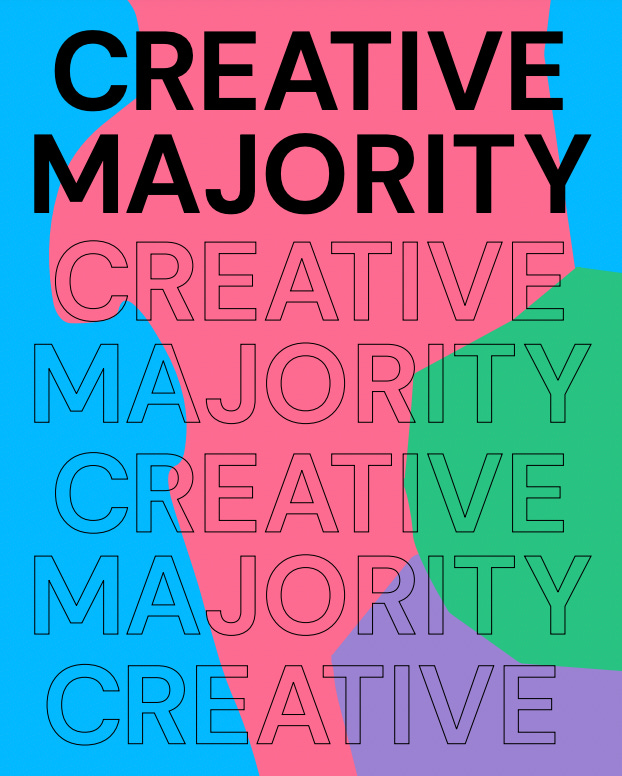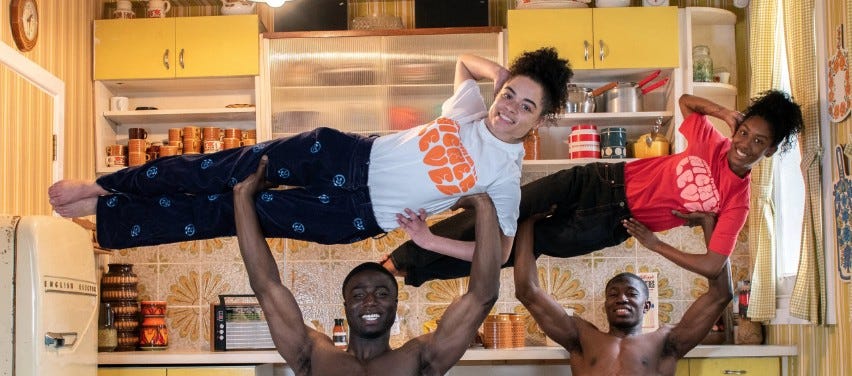Can we solve the creative industry's class problem?
We’re living in a broken system, but that doesn’t mean we can’t fix it
MØRNING. Just like that, it’s April. Which means we’re back with another sprinkle of MØRNING People Fund magic. Last round we saw over 1000 applications from 40 (!) countries. Thank you so much for anyone that applied so far, it was so difficult to choose a winner and we wholeheartedly encourage you to reapply - we have lots of exciting plans in the works <3 Click here for all the juice.
The MØRNING People Fund is our chance to give back to the culture that feeds us all, and to encourage you to do the same. Yes, we’re living in a broken system, but that doesn’t mean we can’t fix it. The first point of call? Understanding where exactly we’re going wrong. This week, founder of Common People, Tom Armstrong is here with all the home truths about class inequality in the creative industries: How big is the issue? What hand does the government have in this? What can we do to change things? We hope this week’s Burn After Reading sheds some light on what we’re dealing with, and how we can find ways forward.
It’s the last taboo. The elephant in the meeting room. Difficult to define, awkward to measure, the issue of Class inequality has been repeatedly kicked into the long grass by a creative sector that prefers quick and easy diversity wins. But the effects are becoming impossible to ignore, with growing media attention and celebrities speaking up. It’s now time for the industry to take action to ensure Class becomes more than just another diversity buzzword.
What’s The Problem?
Only 16% of people working full time in a creative role are from a Working Class background, according to a 2021 report. That number drops to 5% outside of London and the South East.
In fact, despite a reputation as a beacon of progressive thought, the creative industries would need to employ 265,000 more Working Class people just to be as socially diverse as the rest of the economy, trailing law, academia and even finance for social mobility. None of that will come as a surprise if you happen to be one of the council housed, state-schooled commoners who found their way in, battling the financial barriers and cultural biases which so often stop talent from reaching its potential. To everybody else, it should be a big wake up call.
What Do We Mean By Class?
Class today is a complex mix of personal identity, social norms and consumer habits. Channel 4 offers this take in their latest Mirror on the Industry report:
“Class is incredibly hard to describe due to the fact that it isn’t defined by a single factor, it’s not visible or binary, and means different things to different people. Instead, it often hinges on a complex combination of factors including the words you use, your accent, how you dress, where you shop, what kinds of social affiliations you have and what you do for fun – in other words, a mix of unwritten, hidden codes that vary from person to person and are based on assumptions made on visual or audio cues.”
Whether a three-tiered system—with all its caricatures and ideals—still exists or is fit for purpose in 21st Century Britain is another discussion, but one thing remains certain: the idea that people on the lower end of the economic scale are less capable, less intelligent and less trustworthy absolutely still exists. We see it permeate every aspect of our society, from the top down, and it’s what drives the rampant inequality in creative workplaces.
It’s why 77% of people working in the creative industries feel they need to change their accent to be taken more seriously.
It’s why social background, above all else, is statistically the biggest barrier to a career in music.
And it’s why those from lower socio-economic backgrounds earn less than half of what their more privileged counterparts do in their first job after full-time education.
A Note On Intersectionality…
Research from the Social Mobility Foundation shows that Class intersects with ethnicity, gender and disability, to compound disadvantages for certain groups. As an example, men from privileged backgrounds are five times more likely to work in the creative industries than Working Class women. Even in multicultural London, privileged white men are twice as likely to work in a creative role than those from ethnic minority Working Class backgrounds. This is central to the understanding of inequality in the workplace.
By overlooking socio-economic background, existing strategies have only scratched the surface of the issue. Class underpins it all.
Men from privileged backgrounds are five times more likely to work in the creative industries than Working Class women
We Need To Wake Up To The Politics Of This
There’s an obvious moral issue here: a person’s upbringing should not be an obstacle to a creative career. We all know this, but it’s 2024 and it’s still happening, on a big scale, and that’s a problem.
But there’s another danger.
The creative industries aren’t the trifling fluff that our current government would have you believe. They shape everything we see, read and feel about ourselves as a society. The government knows this. It’s why they have systematically slashed arts funding while dismantling the parts of the state education system that encourage students to think for themselves.
The creative boom that saw Britain become a cultural powerhouse over the last six decades happened because ordinary Working Class people felt inspired to challenge the status quo and create a world apart from the one they’d inherited. To silence those voices is to see Britain slide into a state of hopeless, obedient stagnation. A little less inspiring to each new generation. A Britain where Coldplay headline every festival, forever.
The government have systematically slashed arts funding, while dismantling the parts of the state education system that encourage students to think for themselves
Classism, But Make It Fashion
Let’s take fashion as a case study, as it happens to be the industry I work in.
Fashion has become the most infamous example of an industry that repackages and sells Working Class culture, while upholding systems which stop those people from sharing in the profits. Individual success stories, from Martine Rose to McQueen, are offered as examples of the industry’s egalitarianism, but as the British Fashion Council’s latest DEI report shows, it has been slow to address a lack of diversity behind the scenes, with socio-economic background especially overlooked.
You don’t have to dig very deep to find examples. Fashion’s reliance on unpaid interns is notorious, and this system continues to be propped up by large companies willing to exploit young people’s desire for a career doing what they love. Those who can’t afford to take part simply get left out. Only until very recently has this practice been questioned.
But if you do manage to get in, getting on is another minefield. Working Class creatives are often hired as freelancers for their ‘cultural expertise’ (read as: ‘we need a photoshoot on a council estate’), while the stable desk jobs with opportunities for progression are reserved for those with ‘polish’, a dog-whistle term for a private education. The result is a wave of monocultural meeting rooms churning out safe, bland work.
Where do we go from here?
I was inspired to co-found Common People with a group of industry friends after years of feeling as though we were the odd ones out at work because we’d lived in a council house or had never been skiing. We started a WhatsApp group, everybody invited a friend, and within 48 hours we’d discovered 300 other people who also thought they were the only ones. The stories of exclusion and outright discrimination, right across the board, opened everybody’s eyes to the scale of the problem.
The impact of finding my people, both professional and emotional, was immediate and gave me the confidence to continue on a career path I’d considered leaving. We now run a monthly Substack full of mentoring, volunteering, work and networking opportunities. Please do sign up, whatever your background, and drop us a message any time to chat.
And as for brands…
Difficulty defining Class shouldn’t be an excuse to do nothing. It’s been brilliant to see a growing awareness of these issues in the wider media, but it has to lead to long term action to avoid further disillusionment and division.
Brands, if brands you want to escape from the stagnant pool of bland, safe work out there right now, and contribute to culture rather than stand on the sidelines:
Hire! from the huge pool of unpretentious, hard working and creative Working Class talent waiting to be discovered.
Make Class and / or socio-economic background a protected characteristic in your diversity policy. The Social Mobility Commission has put together an excellent toolkit to help bring Class into DE&I strategies, tailored towards creative workplaces.
Reconsider educational requirements at entry level - granted, life experience isn’t always a replacement for rigorous training (I wouldn’t fancy visiting a dentist who’s learned on the job) but this is the ideas game, and creativity thrives in an unbound mind.
Lobby your bosses to review entry requirements! Ask if you can start an initiative to hire working class creatives! Keep supporting your fellow creatives! Share this article! And if you’re struggling to find your way in a hostile system, head to Common People for a treasure trove of resources and advice. What’s for sure: everyone has a part to play in shifting the dial and everyone benefits from allowing more diverse creativity to thrive.
‘Til next time.










Creative agencies (and the Marcom teams at their clients) have a few massive blindspots. The biggest gaps (in my opinion as a fancy Group Brand Strat Director at an A-List agency) concern a few overlapping themes/cohorts/affinity groups: 1) We obsess over the bleeding edge of what’s trending instead of what’s mass (to the detriment of mass communication), 2) We have no clue what is happening in the inner lives of the hundreds of millions of Americans who watch every NCIS spinoff, 3) we misunderstand what we create as a version of art rather than a tool of persuasion.